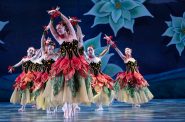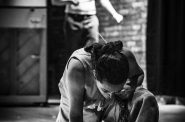Sinfonia New York dances through Baroque repertoire
Two dancers in 17th century Spanish garb danced a flirtatious pantomime to an irresistible repeating melody – Gran Chacona (after Arañes) – played by all seven Sinfonia New York players, to close their Early Music Now concert at the UW-Milwaukee Zelazo Center Saturday evening (March 19). The evening celebrated the chaconne as both a dance and a musical form as it evolved over time. The concert’s joyous finale (see it here) illustrated the origin, not the end of the chaconne.
Patricia Beamon and Carlos Fittante danced three carefully researched restorations of the Baroque form. Their movements included light, irregular leaps and steps – with stiff bodies, almost as though they were marionettes. In one dramatic move, the left leg flails out quickly to the left; as the left foot returns to the floor, the right leg flails, rather like those swinging steel balls on a bored executive’s desk.
The chacona in 17th-century Spain, according to Sinfonia notes, involved full-body undulations, massive hip movements and indecent lyrics. This concert traced the visual/musical history of the chaconne, from its origins as a wild and sacrilegious street dance in Spain to its apotheosis in the Bach Partita in d minor for unaccompanied violin. The company toured Spain, Italy, England, France and Germany as the chaconne spread through Europe from Biber to Bach.
Musically, the chaconne is based on a captivating, repeating triple-meter dance motif that allows for a wide variety of variations to be played above it. The typical Baroque chaconne might involve a cello and harpsichord playing the bass ground and violins, violas or flute seemingly “improvising” an extended set of variations above it. Cellist Christine Gummere sustained the repeating bass line, backed at times by harpiscordist Gordon Scott and Grant Herreid on theorbo (a lute with extended bass strings). String players Judson Griffin, Clarie Jolivet and Theresa Salomon and flutist Sandra Miller played the variations.
Gut strings added a grittier sound than contemporary instruments. Short strokes and brief melodic lines fitting within the bass line beat added an edginess to most works. Theresa Salomon “fiddled” through extensive variations in a colorful interpretation of Antonio Bertali’s Chiaconna for violin and continuo. Griffen, Jolivet and Salomon exchanged variations and at turns echoed the bass dance line in Henry Purcell’s 3 Parts on a Ground in D major. Sandra Miller’s period wooden flute sounded a mellow tone on a pastoral tune by François Courperin – Le Rossignol-en-amour.
Soprano Nell Snaidas demonstrated the range of vocal colors appropriate to the sentiments, to match a cheerful drinking song, several love songs and a dramatic lament. In Monteverdi’s Quel sguardo sdegnosetto, she flirted with her love – “let lips not be slow to revive me when I am slain.” That contrasted with G.H. Stölzel’s familiar and more tender love song – Bist du bei mir (When you are with me). The lament – Queen Dido’s song after being abandoned by Trojan hero Aeneas in Purcell’s early opera Dido and Aeneas – filled the air with despair; “Death is now a welcome guest.” Snaides’ voice was strong, clear and expressive.
Judson Griffin opened the concert with an earlier violin solo, Heinrich Biber’s Passacaglia in g minor. It challenges as Bach’s partita does, but with even more striking variations over a basic bass line. Biber’s 17th century works sound very modern; they aren’t played enough.
The program’s disparate works fit together well as the unifying theme unfolded. Sinfonia New York effectively demonstrated the valuable role of dance motifs as a source of energy and interest in Western classical music.
Early Music Now’s last concert of the season – “The Six Wives of Henry VIII” will feature The Flanders Recorder Quartet at Wisconsin Lutheran College on April 30th. More information here.
Dance
-
Milwaukee Ballet Brings Back Orchestra
 Jul 14th, 2025 by Bruce Murphy
Jul 14th, 2025 by Bruce Murphy
-
New Riverwest Company, Production Impresses
 Feb 10th, 2020 by Brendan Fox
Feb 10th, 2020 by Brendan Fox
-
Milwaukee Ballet Show Remakes History
 Feb 10th, 2020 by Catherine Jozwik
Feb 10th, 2020 by Catherine Jozwik





















